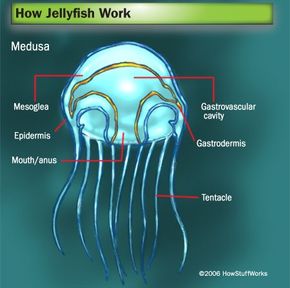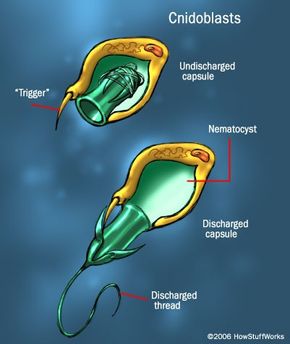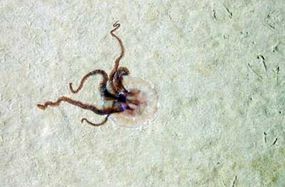Quck answer
Jellyfish are fascinating creatures that have been around for millions of years. They are not really fish, but invertebrates that belong to the phylum Cnidaria, which also includes corals and sea anemones. Jellyfish are known for their bell-shaped bodies and long, trailing tentacles that can deliver a painful sting.
Jellyfish use their tentacles to capture prey, which they then bring to their mouth, located on the underside of their bell-shaped body. They do not have a brain or a central nervous system, but instead have a network of nerves called a nerve net. This nerve net allows them to respond to their environment and move through the water.
Jellyfish also have a unique ability to regenerate their cells, which allows them to repair any damage they may sustain. Some species of jellyfish are bioluminescent, meaning they can produce their own light, which they use for defense and to attract prey.
Overall, jellyfish are fascinating creatures that continue to amaze scientists and marine enthusiasts alike with their unique abilities and adaptations.
Wild Animals

With their unique gelatinous bodies and long tentacles, jellyfish are among the most mysterious creatures in the world. Despite their strange appearance and the fact that their sting can be harmful, they are fascinating creatures. Jellyfish have been around for over 650 million years and new species are still being discovered.
Although jellyfish live in the ocean, they are not fish but are classified as plankton. They range in size from less than an inch to almost 7 feet long with tentacles that can be up to 100 feet long. Jellyfish are members of the phylum Cnidaria and the class Scyphozoa. They have radial symmetry and have a simple body without bones, brain, or heart. Their sensory nerves help them see light, detect smells, and orient themselves.
A jellyfish’s body is composed of six basic parts: the epidermis, the gastrodermis, the middle jelly or mesoglea, the gastrovascular cavity, the orifice that functions as both the mouth and anus, and the tentacles. Adult jellyfish are called medusa and after releasing their sperm, the fertilized eggs hatch into several dozen larvae, which float out on the currents and attach themselves to a solid surface. They then become polyps, which later develop into young jellyfish called ephyrae.

Despite being made up of 98 percent water, jellyfish are fascinating creatures that have survived for millions of years.
Reports of Jellyfish Invasion in Japan
Recent reports from Japan suggest that the country is currently experiencing an invasion of jellyfish, causing problems for the fishing industry and even disrupting a nuclear power plant. These giant echizen kurage, as they are known in Japan, can grow up to 6 feet long and weigh up to 450 pounds. It is thought that heavy rains in China have caused the influx of jellyfish into Japanese waters. Despite the issues they are causing, the Japanese have found a way to use the jellyfish by catching and drying them to create a salty snack.
Understanding the Jellyfish Sting

Jellyfish are carnivorous and eat smaller animals, such as algae and plankton, or larger aquatic creatures, like crustaceans. Their sting, which is both a defense mechanism and a way to capture prey, is caused by cells called cnidoblasts that contain nematocysts with stinging threads. When pressure is applied to the nematocyst, the threads uncoil and release venom into the victim. Although this venom is designed to paralyze jellyfish prey, it is not usually fatal to humans. However, it can cause pain, skin rashes, fever, and muscle cramps, with the severity of the reaction depending on the species of jellyfish and the size of the cnidoblasts.

Jellyfish on the beach
Image courtesy Captain Albert E. Theberge/NOAA
It is important to watch out for jellyfish when at the beach, both in the water and on the sand, as even a separated tentacle can still sting. If stung, remove any tentacles and avoid washing the area with fresh water, which can release more venom. Instead, use rubbing alcohol, vinegar, ammonia, or urine to clean the area. Meat tenderizer or a mixture of baking soda and water can also be applied. Any signs of an allergic reaction require immediate medical attention.

Jellyfish salad, a common appetizer in Asia
Public domain
Jellyfish have natural protection against predators due to their stinging tentacles and transparent bodies that help them hide. Some animals, like loggerhead turtles and spadefish, eat jellyfish, while others, like young fish, hide in the tentacles to avoid being eaten. In some countries, such as China and Japan, jellyfish are even considered a delicacy and are served as a salad.
Jellyfish are generally not a problem, except for their occasional stings. However, in certain parts of the world such as Japan, Australia, and Europe, there has been a significant increase in jellyfish populations. This increase can be attributed to various factors such as additional nutrients in the water, climate change, and fishing along the coastlines. This increase is known as blooms and can lead to competition for food resources with fish and other marine animals, eventually pushing out the native local species. Jellyfish can also disrupt local fishing industries by tearing holes in fishing nets and disrupting other fish populations. Although jellyfish do best in their natural habitat, many aquariums have jellyfish tanks. People who capture and raise jellyfish in captivity must be careful not to damage their fragile bodies. Different types of jellyfish include box jellyfish, deep-sea jellyfish, Irukandji jellyfish, and moon jellyfish. A Portuguese man-o’-war is not a jellyfish, but a siphonophore consisting of four individual animals with distinct roles.
The Portuguese man-o’-war, which resembles an 18th century ship, belongs to the same phylum as jellyfish, Cnidaria. Its sting is very painful and can cause symptoms such as fever, chills, shock, nausea, vomiting, and in some cases, even death.
Read More
Jellyfish Overview
Jellyfish are ancient sea creatures that have lived in oceans around the world for millions of years. Despite their graceful movements and gelatinous bodies, they are relatively simple in structure and function. Jellyfish are planktonic creatures that lack bones, brains, or hearts. They are mostly composed of water and have only six main body parts. They can range in size from less than an inch to more than 7 feet long and live for 3-6 months. While not inherently aggressive, jellyfish are infamous for their painful stings. They use their tentacles primarily for hunting, but can also sting in self-defense. Jellyfish only sting humans when they feel threatened, as humans are too large for jellyfish to eat. Besides their stings, there is no need to fear these ancient sea creatures.
Top 5 Facts About Jellyfish
- Jellyfish have been around for over 650 million years and there are thousands of different species around the world.
Learn more about how jellyfish function.
- Jellyfish are not actually fish; they are plankton that belong to the phylum Cnidaria and the class Scyphozoa.
Discover more facts about jellyfish.
- Jellyfish are made up of 98% water and have only six main body parts:
- epidermis
- gastrodermis
- mesoglea
- gastrovascular cavity
- orifice
- tentacles
Learn all about jellyfish.
- Jellyfish have three main developmental stages:
- Polyps – baby jellyfish
- Ephrae – young jellyfish
- Medusae – adult jellyfish
Learn more about jellyfish development.
- Although jellyfish are not aggressive by nature, their sting is painful and sometimes dangerous. There are several remedies for jellyfish stings, including:
- ammonia
- vinegar
- meat tenderizer
- baking soda mixed with water
- urine
ВВLearn all about jellyfish stings.
Originally published on September 22, 2006.
Jellyfish Frequently Asked Questions
Do jellyfish have eyes?
Jellyfish have a complex visual system with approximately 24 eyes. However, only two of them can detect color.
How many tentacles do jellyfish have?
While many jellyfish have four to eight tentacles hanging from their bell, some species have hundreds.
How many types of jellyfish exist?
Around the world, there are approximately 2,000 documented species of jellyfish. Nevertheless, similar to most marine creatures, it is believed that many more species exist but have not yet been discovered.
What do jellyfish consume?
Jellyfish are carnivorous and opportunistic eaters. They are not selective and tend to consume any sea organism that can fit into their mouths, including fish eggs and larvae. Jellyfish are also known to be cannibalistic and consume other jellyfish.
Where do jellyfish live?
Jellyfish are primarily marine animals and, therefore, inhabit saltwater bodies. They can be found in all oceans worldwide, in regions that have ocean currents.
Learn More
Related HowStuffWorks Articles
- How Sharks Work
- How Shark Attacks Work
- How Whales Work
- How the Georgia Aquarium Works
- How do Sea Monkeys work?
- How do fish rise and sink in water?
Additional Resources
- Great Barrier Reef Explorer
- Monterey Bay Aquarium
- National Institutes of Health: Jellyfish Sting
- Oregon Coast Aquarium
Sources
- Buddin, Elizabeth. “Sea Science: Jellyfish.” http://www.dnr.sc.gov/marine/pub/seascience/jellyfi.html
- Dock Watch: Dauphin Island Sea Lab http://dockwatch.disl.org/overview.htm
- “Hope for lethal jellyfish cure.” BBC News, January 31 2003. http://news.bbc.co.uk/2/hi/health/2713211.stm
- Introduction to the Scyphozoa: University of California Museum of Paleontology http://www.ucmp.berkeley.edu/cnidaria/scyphozoa.html
- Jaques, Susan. “Swimmers Beware: Jellyfish are Everywhere! ” http://www.nationalgeographic.com/ngkids/9608/jellyfish/
- Jellies: Phantoms of the Deep.” Tennessee Aquarium Newsroom. http://www.tennis.org/newsroom/jelliesfacts.asp
- “Jellyfish.” Gale Encyclopedia of Science. Thomson Gale, 2001.
- National Marine Aquarium Library http://www.national-aquarium.co.uk/databases/FAQsLibrary/index.asp?FAQCategoryID=&FAQID=859&SearchText=
- Nielsen, John. “Jellyfish Take Over an Over-Fished Area.” All Things Considered, NPR, July 21, 2006. http://www.npr.org/templates/story/story.php?storyId=5573968
- “Nuclear Plant Struck by Jellyfish.” BBC News, July 2006. http://news.bbc.co.uk/2/hi/asia-pacific/5197846.stm
- Parry, Richard Lloyd. “How do you tackle aninvasion of giant jellyfish? Try making sushi .” The Times, December 07, 2005. http://www.timesonline.co.uk/article/0,,25689-1910322,00.html
- Pastino, Blake de. “Giant Jellyfish Invade Japan.” National Geographic News, January 19, 2006. http://news.nationalgeographic.com/news/2006/01/0119_060119_jellyfish.html
- Those That Sting http://www.aquarium.org/jellies/
FAQ
1. What are jellyfish and how do they differ from other marine creatures?
Jellyfish are gelatinous sea creatures that belong to the phylum Cnidaria. They are different from other marine creatures because they don’t have brains, bones, or even hearts. Instead, they have a simple nerve net that helps them detect light and movement.
2. How do jellyfish move?
Jellyfish move by contracting their muscles and releasing water. This propels them forward in a pulsing motion. They don’t swim in a straight line, but rather move in a wavy, meandering path.
3. What do jellyfish eat?
Jellyfish are carnivorous and feed on small fish, plankton, and other jellyfish. They use their tentacles, which are lined with stinging cells called nematocysts, to capture their prey.
4. How do jellyfish reproduce?
Jellyfish have a unique life cycle that involves both sexual and asexual reproduction. They release sperm and eggs into the water, where they fertilize and develop into a larval stage called a planula. The planula eventually settles on a surface and grows into a polyp, which can reproduce asexually by budding off new jellyfish.
5. Are jellyfish dangerous?
While most jellyfish don’t pose a threat to humans, some species have powerful stings that can be painful or even deadly. It’s important to be aware of jellyfish in the water and to take precautions, such as wearing protective clothing or avoiding areas where jellyfish are known to congregate.
6. Can jellyfish live outside of water?
No, jellyfish are completely dependent on water to survive. If they are removed from the water, they will quickly dry out and die.
7. How long do jellyfish live?
The lifespan of a jellyfish varies depending on the species, but most live for less than a year. Some smaller species may only live for a few days or weeks, while larger species can live for several years.
8. How are jellyfish important to the marine ecosystem?
Jellyfish play an important role in the marine ecosystem by providing food for other creatures and helping to regulate the population of certain species. They also help to cycle nutrients through the water column and can be indicators of changes in ocean conditions.
9. Can jellyfish be kept as pets?
While some people do keep jellyfish as pets in specialized aquariums, it’s important to note that they can be difficult to care for and require specific water conditions. It’s also important to research the specific species to ensure that it is legal to own and won’t pose a threat to other marine life.





Leave a Reply